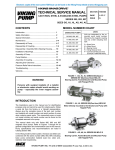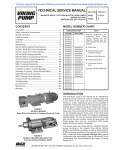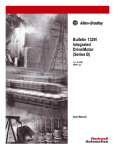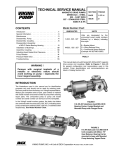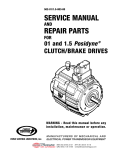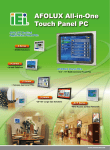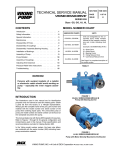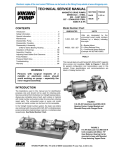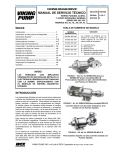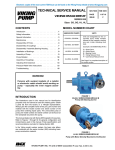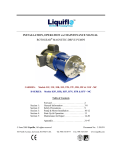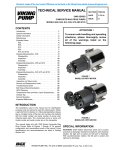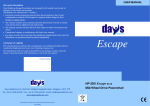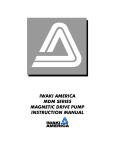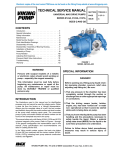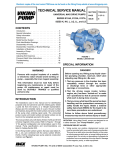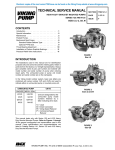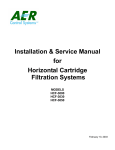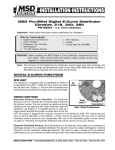Download Viking Pump Technical Service Manual 680 for Cast Iron
Transcript
TECHNICAL SERVICE MANUAL CAST IRON, STEEL & Stainless steel pumps SERIES 895, 893, 897 SECTION TSM 680 PAGE 1 of 17 ISSUE e SIZES GG, HJ, HL, AS, AK, AL CONTENTS MODEL NUMBER CHART Introduction................................................................... 1 Special Information....................................................... 3 Maintenance................................................................. 3-4 Disassembly of Pump................................................... 4-7 UNMOUNTED PUMPS GG-895, 893, 897 HJ-895, 893, 897 Disassembly of Coupling.............................................. 7-9 HL-895, 893, 897 Disassembly / Assembly MD-C Bearing Housing......... 10 AS-895, 893, 897 Installation of Bushings................................................ 10 AK-895, 893, 897 Assembly of Pump....................................................... 11 Pump Rotation.............................................................. 11 AL-895, 893, 897 UNITS Units are designated by the unmounted pump model numbers followed by the magnetic coupling size and a letter indicating drive style. D = Direct Drive M = Motor Mount B = Bearing Carrier R = Viking Reducer Drive P = Commercial Reducer Drive (Example: HJ895 MD-A9 R) Assembly of Coupling................................................... 12-14 Adjusting End Clearance.............................................. 15 Pressure Relief Valve Instructions................................ 15 Troubleshooting............................................................ 17 WARNING! Persons with surgical implants of a metallic or electronic nature should avoid working on pump – especially the inner magnet assembly. FIGURE 1 - GG, HJ, HL SERIES 893(Steel) or SERIES 897 (Stainless Steel) MD-A B Bearing Carrier, Footed Bracket and Mounted Pump with Flanged Ports INTRODUCTION The illustrations used in this manual are for identification purposes only and cannot be used for ordering parts. Obtain a parts list from the factory or a Viking® representative. Always give the complete name of the part, part number and material with model number and serial number of pump when ordering repair parts. The unmounted pump or pump unit model number and serial number can be found on the nameplate secured to the pump. FIGURE 2 - HJ, HL SERIES 895(Cast Iron) MD-B M Motor Directly mounted to the Bracket and Pump with Tapped Ports This manual deals only with Series 895, 893 and 897 magnetic drive pumps. Refer to Figures 1 through 44 for general configuration and nomenclature used in this manual. Pump specifications and recommendations are listed in Catalog Section 680. In the Viking model number system, the basic size letters are combined with the series number (895, 893, 897) indicating basic pump construction material (cast iron, steel, and, stainless steel respectively). FIGURe 3 - as, ak, al series 895 md-c b Bearing Carrier, Footed Bracket and Mounted Pump with Tapped Ports VIKING PUMP, INC. • A Unit of IDEX Corporation • Cedar Falls, IA 50613 USA SAFETY INFORMATION AND INSTRUCTIONS IMPROPER INSTALLATION, OPERATION OR MAINTENANCE OF PUMP MAY CAUSE SERIOUS INJURY OR DEATH AND/OR RESULT IN DAMAGE TO PUMP AND/OR OTHER EQUIPMENT. VIKING’S WARRANTY DOES NOT COVER FAILURE DUE TO IMPROPER INSTALLATION, OPERATION OR MAINTENANCE. THIS INFORMATION MUST BE FULLY READ BEFORE BEGINNING INSTALLATION, OPERATION OR MAINTENANCE OF PUMP AND MUST BE KEPT WITH PUMP. PUMP MUST BE INSTALLED, OPERATED AND MAINTAINED ONLY BY SUITABLY TRAINED AND QUALIFIED PERSONS. THE FOLLOWING SAFETY INSTRUCTIONS MUST BE FOLLOWED AND ADHERED TO AT ALL TIMES. Symbol Legend : ! ! Danger - Failure to follow the indicated instruction may result in serious injury or death. BEFORE opening any liquid chamber (pumping chamber, reservoir, relief valve adjusting cap fitting, etc.) be sure that : ● Any pressure in the chamber has been completely vented through the suction or discharge lines or other appropriate openings or connections. ● The pump drive system means (motor, turbine, engine, etc.) has been “locked out” or otherwise been made non-operational so that it cannot be started while work is being done on the pump. WARNING WARNING ! WARNING ● You know what material the pump has been handling, have obtained a material safety data sheet (MSDS) for the material, and understand and follow all precautions appropriate for the safe handling of the material. ! ! ! ! WARNING ! WARNING BEFORE operating the pump, be sure all drive guards are in place. DO NOT operate pump if the suction or discharge piping is not connected. ! ! DO NOT place fingers into the pumping chamber or its connection ports or into any part of the drive train if there is any possibility of the pump shafts being rotated. DO NOT exceed the pumps rated pressure, speed, and temperature, or change the system/duty parameters from those the pump was originally supplied, without confirming its suitability for the new service. ! WARNING BEFORE operating the pump, be sure that: ● It is clean and free from debris ● all valves in the suction and discharge pipelines are fully opened. ● All piping connected to the pump is fully supported and correctly aligned with the pump. ● Pump rotation is correct for the desired direction of flow. ! WARNING SECTION TSM 680 ISSUE E PAGE OF 17 Warning - In addition to possible serious injury or death, failure to follow the indicated instruction may cause damage to pump and/or other equipment. INSTALL pressure gauges/sensors next to the pump suction and discharge connections to monitor pressures. USE extreme caution when lifting the pump. Suitable lifting devices should be used when appropriate. Lifting eyes installed on the pump must be used only to lift the pump, not the pump with drive and/or base plate. If the pump is mounted on a base plate, the base plate must be used for all lifting purposes. If slings are used for lifting, they must be safely and securely attached. For weight of the pump alone (which does not include the drive and/or base plate) refer to the Viking Pump product catalog. DO NOT attempt to dismantle a pressure relief valve that has not had the spring pressure relieved or is mounted on a pump that is operating. AVOID contact with hot areas of the pump and/or drive. Certain operating conditions, temperature control devices (jackets, heat-tracing, etc.), improper installation, improper operation, and improper maintenance can all cause high temperatures on the pump and/or drive. THE PUMP must be provided with pressure protection. This may be provided through a relief valve mounted directly on the pump, an in-line pressure relief valve, a torque limiting device, or a rupture disk. If pump rotation may be reversed during operation, pressure protection must be provided on both sides of pump. Relief valve adjusting screw caps must always point towards suction side of the pump. If pump rotation is reversed, position of the relief valve must be changed. Pressure relief valves cannot be used to control pump flow or regulate discharge pressure. For additional information, refer to Viking Pump’s Technical Service Manual TSM 000 and Engineering Service Bulletin ESB-31. THE PUMP must be installed in a matter that allows safe access for routine maintenance and for inspection during operation to check for leakage and monitor pump operation. SPECIAL INFORMATION For additional information on pressure relief valves, refer to Technical Service Manual TSM000 and Engineering Service Bulletin ESB-31. DANGER ! RELIEF VALVE ADJUSTING SCREW CAP Before opening any Viking pump liquid chamber (pumping chamber, reservoir, relief valve adjusting cap fitting etc.) Be sure: 1.That any pressure in the chamber has been completely vented through the suction or discharge lines or other appropriate openings or connections. 2.That the driving means (motor, turbine, engine, etc.) Has been “locked out” or made non- operational so that it cannot be started while work is being done on pump. DISCHARGE SUCTION 3.That you know what liquid the pump has been handling and the precautions necessary to safely handle the liquid. Obtain a material safety data sheet (MSDS) for the liquid to be sure these precautions are understood. Failure to follow above listed precautionary measures may result in serious injury or death. ROTATION: Viking Mag Drive pumps are designed to run in the direction indicated on the nameplate only. If rotation must be reversed, See PUMP ROTATION, page 11. PRESSURE RELIEF VALVES: 1. Viking pumps are positive placement pumps and must be provided with some sort of pressure protection. This may be a relief valve mounted directly on the pump, an inline pressure relief valve, a torque limiting device or a rupture disk. Do not rely on decoupling of magnets for protection from over pressure; this may result in damage to the magnets, pump, or other equipment. 2. Relief valves are mounted as standard on the head of GG, HJ, and HL size pumps and on the casing of AS, AK, and AL size pumps. Relief valves are not available on jacketed heads (GG, HJ & HL). 3. If the pump rotation is to be reversed during operation, pressure protection must be provided on both sides of the pump. Figure 4 CAUTION ! Rare earth magnets used in couplings have extremely strong magnetic fields capable of changing performance or damaging items such as the following: Pacemakers Metal Implants Watches Computers & disks Credit Cards Completely assembled magnetic couplings will not affect items listed above – only disassembled components. There are no known harmful effects of these magnetic fields on the human body. MAINTENANCE 4. The relief valve adjusting screw cap must always point towards the suction side of the pump. See Figure 4. If the pump rotation is reversed, remove the pressure relief valve and turn end for end (see PUMP ROTATION, page 11 first for additional steps required for proper operation). Series 895, 893 and 897 pumps are designed for long, trouble-free service life under a wide variety of application conditions with a minimum of maintenance. The points listed below will help provide long service life. 5. Pressure relief valves cannot be used to control pump flow or regulate discharge pressure. Keep the pump as clean as possible. This will facilitate inspection, adjustment and repair work. CLEANING PUMP: SECTION TSM 680 ISSUE E PAGE OF 17 BEARING CARRIER ASSEMBLY CANISTER TEMPERATURE PROBE CANISTER O-RING CASING BUSHING SHAFT ROTOR BALANCE PLATE HEAD IDLER PIN OUTER MAGNET ASSEMBLY BRACKET RELIEF VALVE INNER MAGNET ASSEMBLY RETAINING RING IDLER CASING HEAD GASKET SEAL Cutaway View Mag Drive Pump, Model HL 893 MD-b B Illustrated. (Typical of GG-HL Sizes) FIGURE 5 MAINTENANCE (Cont.) PUMP DISASSEMBLY STORAGE: If the pump and coupling are to be stored, the drain pump and pour non-detergent SAE 30-weight oil into the pump port. Apply grease to the pump or the coupling shaft extension, if present or accessible. Viking suggests rotating the pump shaft every 30 days to circulate the oil in the pump. The coupling should be stored in a dry area. Note: If the liquid to be pumped reacts with oil, use an acceptable alternate. SUGGESTED REPAIR TOOLS: The following tools are required to properly repair Series 895, 893, and 897 pumps. These tools are in addition to standard mechanics’ tools such as open-end wrenches, pliers, screwdrivers, etc. Most of the items can be obtained from an industrial supply house. 1. Soft face hammer 2. Allen wrenches (for set screws) 3. External snap ring pliers - 2-810-029-375 4. Internal snap ring pliers - 2 810-047-999 5. Feeler gauge set 6. Arbor press SECTION TSM 680 ISSUE E PAGE OF 17 WARNING! Refer to DANGER & CAUTION listed on page 2 before proceeding. 1. Refer to Figures 5, 6, 7, 8, 9 & 10 for names of parts. 2. Mark the head and casing before disassembly to insure proper reassembly. 3. Remove the head capscrews. Note: The four valve capscrews, valve and gasket must be removed from the GG models before the six head capscrews are removed. 4. Remove the head from the pump. Do not allow the idler to fall from the idler pin. Tilt the top of the pump head back when removing to prevent this. Avoid damaging the head gasket set since all gaskets are required to maintain end clearance. 5. Remove the idler and bushing assembly. If the idler bushing needs to be replaced, see “INSTALLATION OF BUSHINGS” on page 10. If further disassembly is required, the pump must be separated from coupling. Refer to “DISASSEMBLY OF COUPLING” on pages 7-9 before proceeding with Step 6. MD-B casing MD-a casing Exploded View – Sizes GG, HJ &HL Mag-Drive Pumps FIGURE 6 MD-B casing MD-C casing Exploded View – Sizes AS, AK & AL Mag-Drive Pumps FIGURE 7 ITEM 1 2 3 4 5 6 7 8 NAME OF PART Casing Pilot O-ring Casing Pipe Plug Casing Bushing Balance Plate Capscrew for Balance Plate Capscrew for Inner Magnet Lock Washer ITEM 9 10 11 12 13 14 15 16 NAME OF PART Insert Washer Retaining Ring Key Rotor and Shaft Idler Bushing Idler and Bushing Head Gasket Set Idler Pin ITEM 17 18 19 20 21 22 NAME OF PART Head and Idler Pin Capscrews for Head Gasket for Relief Valve Relief Valve Capscrews for Relief Valve Pipe Plug SECTION TSM 680 ISSUE E PAGE OF 17 M DRIVE CONFIGURATION M DRIVE CONFIGURATION MD-A SERIES COUPLING FIGURE 8 MD-B SERIES COUPLING FIGURE 9 bearing carrier components ITEM DESCRIPTION 1 Setscrew, Outer Magnet (2 Req’d) Outer Magnet Assembly (3 Bore 2 Sizes for A & B Series 3 Shroud, Bracket (MD-B only) 4 Bracket Capscrew for Motor or Bearing 5 Carrier (4 Req’d) 6 Canister SECTION TSM 680 ISSUE E PAGE OF 17 bEARING CARRIER COMPONENTS BEARING CARRIER COMPONENTS MD-C COUPLING FIGURE 10 ITEM DESCRIPTION 7 Inner Magnet Assembly Hex Nuts (Bearing Carrier only, 4 8 Req’d – A & B Series) 9 Lock Washers (A & B Series) 10 Bearing Housing External Retaining Ring (2 Req’d for 11 A & B Series) 12 Bearing Spacer b drive configuriation ITEM DESCRIPTION 13 Ball Bearings (2 Req’d) 14 Inner Retaining Ring 15 16 Shaft Key (2 Req’d – A Series) 17 Key 18 Hand Knobs (C Series) PUMP DISASSEMBLY 6. With the inner magnet removed, now remove the key (not required on AS, AK or AL) and the external retaining ring from the shaft. The rotor and shaft may now be removed by tapping on the end of the shaft with a soft face hammer (If a soft face hammer is not available a regular hammer may be used with a piece of hardwood). separating the bracket from the motor or bearing carrier. Loosen the setscrew on the motor (or bearing carrier) shaft and pull the outer magnet assembly off. If the unit features a bearing carrier, the bearings should not require maintenance since they are sealed. If necessary, disassemble by removing the single internal retaining ring (See Figure 8) then press the shaft and bearings out of the housing. Remove the external retaining rings from the shaft to remove bearings. 7. Remove the balance plate capscrews and pull the balance plate out. PUMP – BRACKET 0.38” CAPSCREWS (2) REQUIRED The casing should be examined for wear, particularly in the area between ports. All parts should be checked for wear before the pump is reassembled. When making major repairs, such as replacing a rotor and shaft, it is advisable to also install a new head and idler pin, idler and bushing, and casing bushings. See “INSTALLATION OF BUSHINGS” on page 10. Clean all parts thoroughly and examine for wear or damage. Check bushings, idler pin and balance plate; replace if necessary. DISASSEMBLY OF COUPLING FIGURE 11 PLACE HANDS BACK HERE Series MD - A4 / A9 Coupling 1. Remove piping to ports and remove the capscrewssecuring pump to bracket. See Figure 11. Support the pump with an overhead hoist if possible. DO NOT PLACE FINGERS HERE CAUTION ! Do not place fingers onto front of pump mounting flange or face of bracket. Using extreme caution, pull inner magnet away from outer magnet. See Figure 12. If you do not completely pull the pump out it will snap back and could pinch a finger or hand. Once the inner magnet is removed from the bracket be careful setting it down as it will attract any steel object. FIGURE 12 INNER MAGNET ASSEMBLY STATIC O-RING RETAINING RINGS CANISTER 2. The canister will probably be full of liquid, therefore use care while removing from the pump and pull straight off. 3. Remove the external retaining ring (closest to the end of the shaft) and slide off the inner magnet assembly (See Figure 13). Do not forget this is a very strong magnet. If pump disassembly is required, remove second external retaining ring. FIGURE 13 CAPSCREWS (4) REQUIRED SETSCREWS (2) REQUIRED 4. Do not remove the o-ring unless it is bad, especially PTFE (Derivative) Encapsulated. If a new o-ring is required, follow instructions in the ASSEMBLY section on page 11. 5. You should be able to visually inspect the outer magnets from the end of the bracket. If removal is necessary, start by removing the (4) capscrews (See Figure 14) and COUPLING BRACKET FIGURE 14 SECTION TSM 680 ISSUE E PAGE OF 17 Series MD - B15 / MD - B40 Coupling PUMP – BRACKET 0.5” CAPSCREWS (4) REQUIRED 1. Remove the piping to the ports and remove the capscrews securing the pump to the bracket (See Figure 15). Support the pump with an overhead hoist if possible. CAUTION ! Do not place your fingers between the pump mounting flange and the face of the bracket. Using extreme caution, pull the inner magnet away from the outer magnet (see figure 16). If you do not completely pull the pump out it will snap back and could pinch a finger or hand. Once the inner magnet is removed from the bracket be careful setting it down as it will attract any iron or steel object. FIGURE 15 PLACE HANDS BACK HERE 2. The canister will probably be full of liquid, therefore use care while removing from the pump and pull it straight off. 3. Insert a brass bar through a port between two rotor teeth and loosen the capscrew holding the inner magnet to the shaft (See Figure 17). Slide the washer, lock washer and inner magnet off the shaft. Do not forget this is a very strong magnet. If pump disassembly is required, remove second external retaining ring. 4. Do not remove the o-ring unless it is bad, especially if PTFE (Derivative) Encapsulated. If a new o-ring is required, follow instructions in the ASSEMBLY section on page 11. 5. You should be able to visually inspect the outer magnets from the end of the bracket. If removal is necessary, start by removing the (4) capscrews (See Figure 18) and separating the bracket from the motor or bearing carrier. Loosen the setscrews on the motor or bearing carrier shaft and pull the outer magnet assembly off. If the unit features a bearing carrier, the bearings should not require maintenance since they are sealed. If necessary, disassemble by removing the single internal retaining ring then press the shaft and bearings out of the housing. Remove the external retaining rings from the shaft to remove the bearings. DO NOT PLACE FINGERS HERE FIGURE 16 INNER MAGNET ASSEMBLY CAPSCREW WASHER LOCK WASHER CANISTER STATIC O-RING RETAINING RING FIGURE 17 INTERNAL RETAINING RING SETSCREWS (2) REQUIRED COUPLING BRACKET CAPSCREWS (4) REQUIRED FIGURE 18 SECTION TSM 680 ISSUE E PAGE OF 17 Series MD – C80 Coupling 1. If the unit has a spacer coupling then the bracket of the mag coupling can stay bolted to base. Without the spacer coupling, either the reducer will need to be removed or the bracket unbolted. Remove the piping to the pump, provide a minimum of 4” of clearance beyond end of coupling shaft. Insert (2) 1/2” hand knobs which have a minimum of 4.5” of full threads into the two tapped holes at the 9:00 and 3:00 o-clock positions on the back of the bearing housing. Remove the (4) 0.38” capscrews. See Figure 19. 0.38” CAPSCREWS (4) REQUIRED HANDKNOBS (2) REQUIRED 2-790-046-999 FIGURE 19 CAUTION ! Do not place your fingers between the pump mounting flange and the face of the bracket. Using extreme caution, pull the inner magnet away from the outer magnet (see figure 21). If you do not completely pull the pump out it will snap back and could pinch a finger or hand. Once the inner magnet is removed from the bracket be careful setting it down as it will attract any iron or steel object. 2. Turn the hand knobs evenly to back out the bearing housing and outer assembly. See Figure 20. FIGURE 20 PUMP – BRACKET 0.5” CAPSCREWS (4) REQUIRED CAUTION ! Do not attempt to pull the magnet assemblies apart by hand until the outer magnet assembly has been backed off 4”. Support the outer magnet assembly and pull completely away from the inner magnet. Be careful when setting down this unit to avoid tools and other metal objects being attracted to the end of the magnet. 3. Support the pump with a hoist and remove the (4) 0.5” capscrews. See Figure 21. Pull the pump out of the bracket; there will be some resistance since the inner magnet assembly will be attracted to the iron bracket. If further disassembly of the bearing carrier is required, refer to page 10. Since there will be some liquid left in the canister, be aware that the liquid may run out when the canister is removed from the pump. 4. Insert a brass bar through a port between two rotor teeth and loosen the capscrew holding the inner magnet to the shaft. See Figure 22. Slide the washer, lock washer and inner magnet off the shaft. Do not forget this is a very strong magnet. If pump disassembly is required, remove the external retaining ring. 5. Do not remove the o-ring unless it is bad, especially if PTFE (Derivative) Encapsulated. If a new o-ring is required, follow instructions in the ASSEMBLY section on page 11. FIGURE 21 INNER MAGNET ASSEMBLY CAPSCREW STATIC O-RING WASHER LOCK WASHER CANISTER RETAINING RING FIGURE 22 SECTION TSM 680 ISSUE E PAGE OF 17 DISASSEMBLY / ASSEMBLY OF BEARING HOUSING PRESS DISASSEMBLY The bearing housing features two sealed ball bearings along with an outer magnet assembly. If further disassembly of this unit is required, proceed as follows: 1. Cover the open end of the outer magnet with a piece of sheet metal or cardboard. This will keep foreign material out of the magnet area. Set the assembly face down with the shaft pointing up and remove the hand knobs. 2. Remove the external retaining ring from shaft, place the unit into a press and push out shaft as shown in Figure 24. Support the outer magnet to prevent it from dropping and possibly being damaged. 3. Remove the internal retaining ring and press out the bearings. FIGURE 24 ASSEMBLY 1. Press one (1) bearing into the housing bore. The pressing tool (2.40” OD x 1.55” ID x 3” long) must seat on both the inner and the outer bearing races. Position the bearing spacer in the bore and insert the second bearing. Press down, insuring the bearing spacer is centered between the inner bearing races, until the bearings bottom out. Install the internal retaining ring into the bearing housing. 2. Set the outer magnet assembly upright in press. Slide the bearing housing over the shaft of the outer magnet assembly until it meets resistance as shown in Figure 25. Place the pressing tool on the end of the bearing and press the housing down until the bearing bottoms out on the shaft shoulder. Install the external retaining ring on the shaft of outer magnet assembly. FIGURE 25 INSTALLATION OF BUSHINGS CARBON GRAPHITE INTERNAL RETAINING RING BEARING HOUSING SPACER SHEET METAL COVER 6.50” SQUARE When installing carbon graphite bushings, extreme care must be taken to prevent breaking. Carbon graphite is a brittle material and easily cracked. If cracked, the bushing will quickly disintegrate. Using a small amount of lubricant on the bushing and mating part will help facilitate installation. The additional precautions listed below must be followed for installation: 1. An arbor press must be used for installation. 2. Be certain the bushing is started straight. 3. Do not stop the pressing operation until the bushing is in the proper position; starting and stopping will result in a cracked bushing. EXTERNAL RETAINING RING 4. Check the bushing for cracks after installation. SILICON CARBIDE BALL BEARINGS FIGURE 23 SECTION TSM 680 ISSUE E PAGE 10 OF 17 When installing silicon carbide bushings into a metal part, the mating part must be heated to 600 °F (preferably in an oven). The bushing must be put into the proper position quickly before the mating part cools down and the bushing heats up. Failure to follow this procedure will result in cracked bushings. ASSEMBLY OF PUMP Use a suitable lubricant compatible with the fluid being handled when reassembling the pump. Inspect all parts, especially drilled holes in the casing for the suck back system, to make sure they are not plugged. Replace any worn parts, remove any burrs, and clean all parts before assembling the pump., 1. If the canister o-ring needs to be replaced, apply a lubricant to the o-ring and place it into the o-ring groove. If the o-ring is PTFE (Derivative) Encapsulated, follow these special instructions. Do not attempt to reuse a PTFE (Derivative) Encapulated o-ring if it has been removed. Immerse a new o-ring in boiling water for a few minutes. Remove it from the water and stretch out the o-ring so it will fit onto the casing hub without forcing it over a sharp edge. Run hot water over the o-ring until it shrinks down tight onto the pilot of the pump. Dry with compressed air. 2. Place the balance plate into the casing bore with counterbores for the capscrews facing out and push it to the bottom of the bore. Align holes to install capscrews. Install the capscrews and tighten evenly to 10 in-lbs. 3. Clean the rotor and shaft so it is free of dirt, grit and other debris and apply lubricant. Push it into the casing as far as it will go. 4. If the old gaskets are not reusable, refer to “ADJUSTING HEAD GASKET END CLEARANCE” on page 15. Otherwise, place the head gaskets on the head. The proper amount of gaskets should be used to provide the correct end clearance. Figure 26 gives the quantity of gaskets available in a gasket set along with standard end clearance. Refer to Techincal ReferenceTR-807 for detailed instructions on setting end clearance. PUMP MODEL NORMAL (A) END CLEARANCE GG 895, 893 0.003 GG 897 0.005 HJ,HL 895, 893 0.005 HJ, HL 893, 897 0.005 AS, AK or AL 895, 893 0.005 AS, AK or AL 897 0.008 SET OF GASKETS INCLUDES 5. Coat the idler pin with a suitable lubricant and place the idler on the idler pin in head. 6. The head can now be assembled onto the pump. Tilt the top of the pump head away from the pump slightly until the crescent enters the inside diameter of the rotor and rotate the idler until its teeth mesh with the rotor teeth. The Pump head and casing should have been marked before disassembly to insure proper reassembly. If not, be sure the idler pin, which is offset in the pump head, is positioned toward and an equal distance from the port connections to allow for proper flow of liquid through the pump. 7. Place the key into shaft keyway and then follow the instructions listed for assembling the appropriate size coupling on pages 12 through 14. CHANGING PUMP ROTATION Cooling circulation in the pump is designed to take fluid from the discharge side of the pump and channel it down the idler pin into the shaft and out the far end of the shaft into the bottom of the canister. The fluid is returned through a hole in the casing back to the suction side of the pump. There are generally three parts, which may need replacing or adjusting. Technical Reference TR-112 provides additional information about changing rotation. Contact your authorized distributor or the factory to request a copy. HEAD & PIN- The hole should be from the discharge side of head to the pin. Some sizes are tapped on both sides and the pipe plug may be moved to the other side of the head but other models will require a new part. BALANCE PLATE- Most designs currently are directional and require a new part. CASING- Some are drilled and tapped for either direction but most feature a single hole and require a second hole for proper return of the cooling fluid. The initial casing hole is generally plugged or restricted with an orifice or by the new balance plate. Contact your local Viking distributor or the factory to determine which parts are required. (1) .015 (2) .007 (2) .005 figure 26 NOTE: End Clearances are adequate for viscosity’s up to 2500 SSU (SAE 40-lube oil at room temperature). Higher viscosity’s require additional clearances. As a general rule the end clearance is doubled for higher viscosity’s. For specific recommendations for end clearance for viscosity or for operating temperatures above 225 °F, check with your Viking representative or consult the factory. SECTION TSM 680 ISSUE E PAGE 11 OF 17 ASSEMBLY OF COUPLING SETSCREWS (2) REQUIRED SETSCREWS (2) REQUIRED Series MD – A4 / A9 Coupling DANGER! 56C, 143TC OR 145TC FOOTED MOTOR OR BEARING CARRIER 182TC OR 184TC FOOTED MOTOR Follow these directions exactly to avoid injury to self or damage to pumping unit. Be careful to keep inner and outer magnets at least (1) foot apart until step 5. Do not engage magnets in any other fashion. OUTER MAGNET ASSEMBLY OUTER MAGNET ASSEMBLY FIGURE 27 1. Inspect the magnets for any steel objects, which may be attached. Remove any foreign material. Apply Loctite and tighten the setscrews onto the motor or bearing carrier key and shaft. Locate outer magnet assembly on the motor shaft per dimension. See Figure 27. 2. Mount the coupling bracket to the motor (or bearing carrier) and secure with the 4 capscrews. See Figure 28. Reach in and rotate the magnets by hand to make sure there is no interference. If rubbing occurs check dimension in Figure 27 or contact the factory. 3. Install the first external retaining ring (in the groove closest to the casing) and the key on the pump shaft. Slide the inner magnet assembly onto the shaft, (the counterbore of the magnet is pointed away from the pump) so that it butts against the snap ring. Install the second external retaining ring (closest to end of shaft) to secure magnet. See Figure 29. 4. Check to make sure the pump rotates freely by turning the inner magnet assembly. Inspect the magnet to make sure it has not picked up any foreign particles, which could damage the pump. Make sure the static o-ring is in good condition and in place. Place the canister onto pump and press on until the canister is in contact with the pump mounting flange. COUPLING BRACKET FIGURE 28 INNER MAGNET ASSEMBLY STATIC O-RING RETAINING RINGS CANISTER FIGURE 29 PLACE HANDS BACK HERE CAUTION ! Do not place fingers onto front of pump mounting flange. Align canister into bore of bracket and gently slide in. When magnets start to engage, the unit will finish engagement on its own very rapidly. Make sure fingers are not on the front of the pump (see figure 30). DO NOT PLACE FINGERS HERE FIGURE 30 PUMP – BRACKET CAPSCREWS (2) REQUIRED 5. Be certain that the power supply to the pump is “Lockedout”. Check that pump rotates freely by spinning motor fan blades or bearing carrier shaft. Finish the assembly by securing the pump to bracket (See Figure 31). Be certain that the power supply to the pump is “Lockedout”. Check that pump rotates freely by spinning motor fan blades or bearing carrier shaft. FIGURE 31 SECTION TSM 680 ISSUE E PAGE 12 OF 17 Series MD – B15 / B40 Coupling 6.82 6.82 SETSCREWS (2) REQUIRED SETSCREWS (2) REQUIRED STANDARD “C” FACE MOTOR DANGER ! Follow these directions exactly to avoid injury to self or damage to pumping unit. Be careful to keep inner and outer magnets at least (1) foot apart until step 4. Do not engage magnets in any other fashion. 1. OUTER MAGNET ASSEMBLY FIGURE 32 0.5” CAPSCREWS (WITH NUTS AND LOCK WASHERS FOR BEARING HOUSING) Inspect the magnets for any steel objects, which may be attached. Remove any foreign material. Locate the outer magnet assembly per dimension (See Figure 32). Apply Loctite and tighten the setscrews onto motor or bearing carrier key and shaft. 2. If the bracket is not fastened to a base, clamp it down See Figure 33. Mount the motor or bearing carrier to the bracket and secure with (4) 0.5” capscrews. Reach in and rotate the magnets by hand to make sure there is no interference. If rubbing occurs check the dimension in Figure 32 or contact the factory. 3. Install the external retaining ring and key on the pump shaft. Slide the inner magnet assembly onto the shaft so that it butts against the retaining ring. Install the washer, lock washer and capscrew to secure the magnet See Figure 34. Insert a brass bar through a port between two rotor teeth and tighten capscrew. 4. Check to make sure the pump rotates freely by turning the inner magnet assembly. Inspect the magnet to make sure it has not picked up any foreign particles, which could damage the pump. Make sure the static o-ring is in good condition and in place. Place the canister onto the pump and press on until it is in contact with the pump mounting flange. OUTER MAGNET ASSEMBLY COUPLING BRACKET FIGURE 33 INNER MAGNET ASSEMBLY CAPSCREW WASHER LOCK WASHER CANISTER CANISTER O-RING RETAINING RING FIGURE 34 PLACE HANDS BACK HERE CAUTION ! Do not place fingers onto front of pump mounting flange. Align canister into bore of bracket and gently slide in. When magnets start to engage, the unit will finish engagement on its own very rapidly. Make sure fingers are not on the front of the pump. See Figure 35. DO NOT PLACE FINGERS HERE FIGURE 35 PUMP – BRACKET 0.5” CAPSCREWS (4) REQUIRED 5. Be certain that the power supply to the pump is “Lockedout”. Finish assembly by securing the pump to the bracket. See Figure 36. Check that pump rotates freely by spinning the motor fan blades or the bearing carrier shaft. FIGURE 36 SECTION TSM 680 ISSUE E PAGE 13 OF 17 Series MD – C80 Coupling DANGER ! Follow these directions exactly to avoid injury to yourself or damage to the pumping unit. Be careful to keep the inner and outer magnets at least (1) foot apart until step 3. Do not engage magnets in any other fashion. INNER MAGNET ASSEMBLY CANISTER CAPSCREW O-RING WASHER LOCK WASHER CANISTER 1. Inspect the magnets for any steel objects attached to the magnets. Remove any foreign material. Place the external retaining ring and key on the pump shaft. Slide the inner magnet assembly onto shaft so it butts against retaining ring. Install the washer, lock washer and capscrew to secure the magnet. See Figure 37. Insert a brass bar through a port between two rotor teeth and tighten the capscrew. RETAINING RING FIGURE 37 PUMP – BRACKET 0.5” CAPSCREWS (4) REQUIRED 2. Inspect the canister o-ring for signs of wear and replace if necessary. Slide the canister over the inner magnet and press it over the o-ring until the canister meets the pump-mounting flange. 3. Support the pump from overhead and secure the coupling bracket to avoid tipping when the pump is attached. Using the canister as a guide, slide the pump and magnet assembly up to the coupling bracket through the smaller opening. Secure with the four 0.5” capscrews. See Figure 38. FIGURE 38 4. The outer magnet should be installed into the bearing housing, if not refer to DISASSEMBLY/ASSEMBLY OF BEARING HOUSING, page 10. Install the hand knobs so that 4” of threads are projecting below housing. Support the bearing housing from over head and gently position the magnet over the canister so the magnet assemblies start to engage. Evenly back out the hand knobs. See Figure 39. The bearing housing should move toward the bracket as the hand knobs are removed. 5. Install the (4) 0.38” capscrew. Turn the output shaft over by hand to make sure the pump rotates freely. See Figure 40. FIGURE 39 0.38” CAPSCREWS (4) REQUIRED FIGURE 40 SECTION TSM 680 ISSUE E PAGE 14 OF 17 ADJUSTING HEAD GASKET END CLEARANCE Use the following procedure to properly adjust the end clearance when replacing gaskets. With the balance plate in position, slide the rotor and shaft into the casing. Insert a feeler gage of the proper thickness into the port and between the face of the rotor and the face of the idler (See Figure 41). Install one 0.015” and one 0.007” gasket onto the head. With the idler on the idler pin, place the head into the pump casing. With the capscrews tight, the feeler gage should fit snugly; otherwise gaskets should be added or removed until the proper clearance is attained. Technical Reference TR-807 will provide addtional information about setting clearances on an internal gear pump. This reference sheet is available through you authorized Viking distributor or contact the factory. FIGURE 41 PRESSURE RELIEF VALVE INSTRUCTIONS DANGER ! Before opening any viking pump liquid chamber (pumping chamber, reservoir, relief valve adjusting cap fitting etc.) Be sure: 1.That any pressure in chamber has been completely vented through suction or discharge lines or other appropriate openings or connections. 2.That the driving means (motor, turbine, engine, etc.) Has been “locked out” or made non- operational so that it cannot be started while work is being done on pump. 3.That you know what liquid the pump has been handling and the precautions necessary to safely handle the liquid. Obtain a material safety data sheet (msds) for the liquid to be sure these precautions are understood. Failure to follow above listed precautionary measures may result in serious injury or death. SECTION TSM 680 ISSUE E PAGE 15 OF 17 DISASSEMBLY – RELIEF VALVE DANGER! Mark the valve and head before disassembly to insure proper reassembly. Before starting pump, be sure all drive equipment guards are in place. 1. Remove the valve cap. 2. Measure and record the length of extension of the adjusting screw. Refer to “A” on Figures 43 and 44. 3. Loosen the locknut and back out the adjusting screw until spring pressure is released. Failure to properly mount guards may result in serious injury or death. PRESSURE ADJUSTMENT 4. Remove the bonnet, spring guide, spring and poppet from the valve body. Clean and inspect all parts for wear or damage and replace as necessary. If a new spring is installed or if the pressure setting of pressure relief valve is to be changed from that which the factory has set, the following instructions must be carefully followed. ASSEMBLY – RELIEF VALVE 1. Carefully remove the valve cap, which covers adjusting screw. Reverse the procedures outlined under DISASSEMBLY – RELIEF VALVE. If the valve is removed for repairs, be sure to replace in the original position. The relief valve adjusting screw cap must always point towards the suction side of the pump. If the pump rotation is reversed, remove the relief valve and turn end for end. Refer to Figure 4, page 3. 2. Loosen the locknut, which locks the adjusting screw so pressure setting will not change during operation of pump. 3. Install a pressure gauge in the discharge line for actual adjustment operation. 4. Turn the adjusting screw in to increase pressure and out to decrease pressure. 5. With discharge line closed at a point beyond pressure gauge, gauge will show the maximum pressure valve will allow while the pump is in operation. IMPORTANT In ordering parts for pressure relief valve, always give model number and serial number of pump as it appears on nameplate and name of part wanted. When ordering springs, be sure to give pressure setting desired. VALVE – GG, HJ AND HL SIZES FIGURE 43 VALVE - LIST OF PARTS 1. Valve Cap 6. Valve Body 2. Adjusting Screw 7. Valve Spring 3. Lock Nut 8. Poppet 4. Spring Guide 9. Cap Gasket 5. Bonnet VALVE – AS, AK AND AL SIZES FIGURE 44 VALVE - LIST OF PARTS SECTION TSM 680 ISSUE E PAGE 16 OF 17 1. Valve Cap 6. Valve Body 2. Adjusting Screw 7. Valve Spring 3. Lock Nut 8. Poppet 4. Spring Guide 9. Cap Gasket 5. Bonnet 10. Bonnet Gasket TECHNICAL SERVICE MANUAL CAST IRON, STEEL & Stainless steel pumps SERIES 895, 893, 897 SECTION TSM 680 PAGE 17 of 17 ISSUE e SIZES GG, HJ, HL, AS, AK, AL TROUBLESHOOTING Some of the following may help pinpoint the problem: Pump does not pump: • • • • • • • • • • Pump has lost its prime from air leak or low level in tank. Suction lift is too high. Pump is rotating in the wrong direction. The strainer may be clogged. The bypass valve is open, the pressure relief valve is set too low or the pressure relief valve poppet is stuck open. Improper end clearance. The pump is worn out. Are there any changes in liquid, system or operation that would influence pump or coupling performance, e.g. new liquid, additional lines or process changes? Temperature changes either in the liquid or the environment. The magnetic coupling is decoupling. Changes in application (temperature, pressure, viscosity, etc.) may require torque beyond coupling capabilities. Pump starts, then loses its prime: • • • The supply tank is empty. Liquid is vaporizing in the suction line. An air leak or air pocket in the suction line. Pump is noisy: • • • • The pump is being starved (heavy liquid cannot get to pump fast enough). Increase the suction pipe size, reduce its length or slow down the pump. The pump is cavitating (liquid vaporizing in suction line). Increase suction pipe size or reduce its length. Check alignment. The magnetic coupling has decoupled. Shut off and restart. WARRANTY Viking warrants all products manufactured by it to be free from defects in workmanship or material for a period of one (1) year from date of startup, provided that in no event shall this warranty extend more than eighteen (18) months from the date of shipment from Viking. If, during said warranty period, any products sold by Viking prove to be defective in workmanship or material under normal use and service, and if such products are returned to Viking’s factory at Cedar Falls, Iowa, transportation charges prepaid, and if the products are found by Viking to be defective in workmanship or material, they will be replaced or repaired free of charge, FOB. Cedar Falls, Iowa. Viking assumes no liability for consequential damages of any kind and the purchaser by acceptance of delivery assumes all liability for the consequences of the use or misuse of Viking products by the purchaser, his employees or others. Viking will assume no field expense for service or parts unless authorized by it in advance. Equipment and accessories purchased by Viking from outside sources which are incorporated into any Viking product are warranted only to the extent of and by the original manufacturer’s warranty or guarantee, if any. THIS IS VIKING’S SOLE WARRANTY AND IS IN LIEU OF ALL OTHER WARRANTIES, EXPRESSED OR IMPLIED, WHICH ARE HEREBY EXCLUDED, INCLUDING IN PARTICULAR ALL WARRANTIES OF MERCHANTABILITY OR FITNESS FOR A PARTICULAR PURPOSE. No officer or employee of IDEX Corporation or Viking Pump, Inc. is authorized to alter this warranty. Pump is not delivering up to capacity: • • • • • • The pump is starving or cavitating - increase suction pipe size or reduce length or reduce pump speed. The strainer is partially clogged. An air leak somewhere in suction line. The pump may be running too slow. Is motor the correct speed and wired up correctly ? The pressure relief valve is set too low, stuck open or has a damaged poppet or seat. The bypass line around the pump is partially open. VIKING PUMP, INC. • A Unit of IDEX Corporation • Cedar Falls, IA 50613 USA © 5/2007 Viking Pump Inc. All rights reserved

















